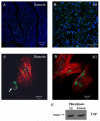Myocardial fibroblast-matrix interactions and potential therapeutic targets
- PMID: 24472826
- PMCID: PMC4005609
- DOI: 10.1016/j.yjmcc.2014.01.008
Myocardial fibroblast-matrix interactions and potential therapeutic targets
Abstract
The cardiac extracellular matrix (ECM) is a dynamic structure, adapting to physiological and pathological stresses placed on the myocardium. Deposition and organization of the matrix fall under the purview of cardiac fibroblasts. While often overlooked compared to myocytes, fibroblasts play a critical role in maintaining ECM homeostasis under normal conditions and in response to pathological stimuli assume an activated, myofibroblast phenotype associated with excessive collagen accumulation contributing to impaired cardiac function. Complete appreciation of fibroblast function is hampered by the lack of fibroblast-specific reagents and the heterogeneity of fibroblast precursors. This is further complicated by our ability to dissect the role of myofibroblasts versus fibroblasts in myocardial in remodeling. This review highlights critical points in the regulation of collagen deposition by fibroblasts, the current panel of molecular tools used to identify fibroblasts and the role of fibroblast-matrix interactions in fibroblast function and differentiation into the myofibroblast phenotype. The clinical potential of exploiting differences between fibroblasts and myofibroblasts and using them to target specific fibroblast populations is also discussed. This article is part of a Special Issue entitled "Myocyte-Fibroblast Signalling in Myocardium."
Keywords: Discoidin Domain Receptor; Extracellular matrix; Fibroblast; Integrin; Myofibroblast; Transformation.
Copyright © 2014 Elsevier Ltd. All rights reserved.
Figures


Similar articles
-
Featured Article: TGF-β1 dominates extracellular matrix rigidity for inducing differentiation of human cardiac fibroblasts to myofibroblasts.Exp Biol Med (Maywood). 2018 Apr;243(7):601-612. doi: 10.1177/1535370218761628. Epub 2018 Mar 4. Exp Biol Med (Maywood). 2018. PMID: 29504479 Free PMC article.
-
Origins of cardiac fibroblasts.J Mol Cell Cardiol. 2016 Feb;91:1-5. doi: 10.1016/j.yjmcc.2015.12.031. Epub 2015 Dec 31. J Mol Cell Cardiol. 2016. PMID: 26748307 Free PMC article. Review.
-
Cardiac Fibrosis and Fibroblasts.Cells. 2021 Jul 6;10(7):1716. doi: 10.3390/cells10071716. Cells. 2021. PMID: 34359886 Free PMC article. Review.
-
May the fibrosis be with you: Is discoidin domain receptor 2 the receptor we have been looking for?J Mol Cell Cardiol. 2016 Feb;91:201-3. doi: 10.1016/j.yjmcc.2016.01.006. Epub 2016 Jan 7. J Mol Cell Cardiol. 2016. PMID: 26772530
-
Has the search for a marker of activated fibroblasts finally come to an end?J Mol Cell Cardiol. 2015 Nov;88:120-3. doi: 10.1016/j.yjmcc.2015.10.005. Epub 2015 Oct 22. J Mol Cell Cardiol. 2015. PMID: 26454160 No abstract available.
Cited by
-
Cytoprotection of Human Progenitor and Stem Cells through Encapsulation in Alginate Templated, Dual Crosslinked Silk and Silk-Gelatin Composite Hydrogel Microbeads.Adv Healthc Mater. 2022 Sep;11(17):e2200293. doi: 10.1002/adhm.202200293. Epub 2022 Jun 22. Adv Healthc Mater. 2022. PMID: 35686928 Free PMC article.
-
EFFECT OF TRIPTOLIDE ON PROLIFERATION AND APOPTOSIS OF ANGIOTENSIN II-INDUCED CARDIAC FIBROBLASTS IN VITRO: A PRELIMINARY STUDY.Afr J Tradit Complement Altern Med. 2016 Nov 23;14(1):145-154. doi: 10.21010/ajtcam.v14i1.16. eCollection 2017. Afr J Tradit Complement Altern Med. 2016. PMID: 28480392 Free PMC article.
-
Combination of ADAM17 knockdown with eplerenone is more effective than single therapy in ameliorating diabetic cardiomyopathy.Front Pharmacol. 2024 May 10;15:1364827. doi: 10.3389/fphar.2024.1364827. eCollection 2024. Front Pharmacol. 2024. PMID: 38799171 Free PMC article.
-
Understanding cardiac extracellular matrix remodeling to develop biomarkers of myocardial infarction outcomes.Matrix Biol. 2019 Jan;75-76:43-57. doi: 10.1016/j.matbio.2017.12.001. Epub 2017 Dec 14. Matrix Biol. 2019. PMID: 29247693 Free PMC article. Review.
-
Adipose extracellular matrix promotes skin wound healing by inducing the differentiation of adipose‑derived stem cells into fibroblasts.Int J Mol Med. 2019 Feb;43(2):890-900. doi: 10.3892/ijmm.2018.4006. Epub 2018 Nov 30. Int J Mol Med. 2019. Retraction in: Int J Mol Med. 2024 Dec;54(6):106. doi: 10.3892/ijmm.2024.5430. PMID: 30535488 Free PMC article. Retracted.
References
-
- Spinale FG. Myocardial matrix remodeling and the matrix metalloproteinases: influence on cardiac form and function. Physiol Rev. 2007;87:1285–1342. - PubMed
-
- Caulfield JB, Borg TK. The collagen network of the heart. Lab Invest. 1979;40:364–72. - PubMed
-
- Eghbali M, Weber KT. Collagen and the myocardium: fibrillar structure, biosynthesis and degradation in relation to hypertrophy and its regression. Mol Cell Biochem. 1990;96:1–14. - PubMed
Publication types
MeSH terms
Substances
Grants and funding
LinkOut - more resources
Full Text Sources
Other Literature Sources

